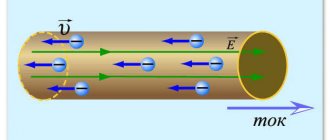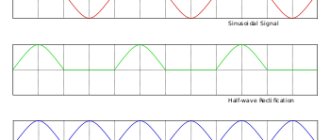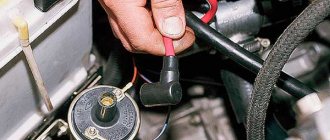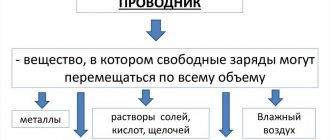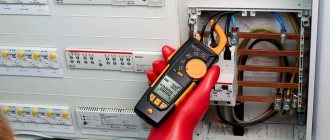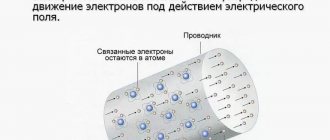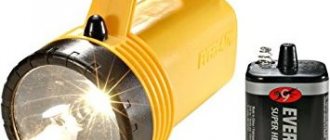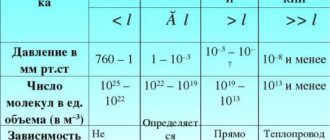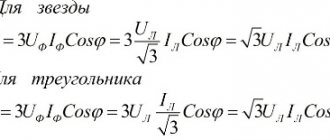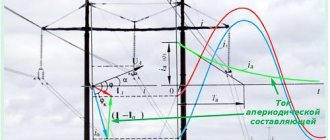Electric current (el current, or simply current) is the driving force of modern human civilization. Without it, plants and factories will shut down, the city will be plunged into darkness, heat and hot water will disappear in homes, and many other benefits and achievements of technological progress will become unavailable. However, despite such a huge role of this phenomenon in human life, many do not know what its essence is, due to which it arises and occurs. This article will discuss what current is, how it arises, where it is used, what particles are its carriers in various substances, what physical laws are basic for this phenomenon.
Electricity
Basic definitions
There are 2 main definitions of this phenomenon: classical and given in academic textbooks. The essence of each of them is as follows:
- The classic definition of electric current is that it is the directed, strictly ordered movement of particles with a charge;
- Academic textbooks state that electric current is the rate at which charge changes over time.
Of the two definitions given, the first is the most frequently used, the second is used less frequently, since it does not describe the essence of the nature of electric current.
War of Currents
Active use of direct current began at the end of the 19th century. Then Edison perfected the light bulb (1890) and founded the first power plants in New York that produced 110 volt direct current.
The use of direct current was associated with significant losses when transmitting it over long distances. Alternating current could not be used due to the lack of adequate meters and motors that operated on alternating current. The process of converting direct current into alternating current was also difficult. At the same time, alternating current could be transmitted over long distances without loss.
At that time, Nikola Tesla came to America from Serbia and got a job at Edison’s company. Tesla invented the alternating current electric motor, realized all the benefits and suggested its use to Edison.
Tesla and Edison
Edison did not listen to Tesla and also did not pay him his salary. Thus began the famous confrontation between inventors - the war of currents.
It lasted more than a hundred years and ended in 2007. Then New York completely switched to alternating current electricity.
Where is electric current used?
Current density - what is it and how is it measured?
This phenomenon has found wide application in such areas of human civilization as:
- Industry;
- Agriculture;
- Utilities;
- Banking sector;
- Transport;
- Information Technology.
In addition to these areas, electricity is the basis of the life of any modern person - without it, the functioning of household appliances, audio, and video equipment, indoor and outdoor lighting, heating boilers, security equipment and other electricity consumers is impossible.
Current characteristics
Current strength is a scalar quantity, determined by the formula
If the current changes, then the charge passing through the cross section of the conductor is defined as the area of the figure limited by the I(t) dependence.
Current density is a vector quantity, determined by the formula
A device for measuring current is called an ammeter. Connected to the network in series. The ammeter's own resistance should be small, since turning on the ammeter should not change the current in the circuit.
Conditions necessary to receive electric current
Ampere - what is it?
The main conditions for the formation of electric current are the following:
- The presence of a source - connected to a generator turbine, battery or solar battery.
- A sufficient number of free charged particles in the conductor;
- The electric field created by the power source and which is the external force that regulates the movement of charges in a conductor and circuit;
- A closed circuit, the ends of which are connected to the poles of the power source.
Only the presence of all these conditions guarantees that a phenomenon such as electric current will flow for a long time in one or another circuit, powering various consumers.
Application
When studying electric current, many of its properties were discovered, which made it possible to find practical application in various areas of human activity, and even to create new areas that would have been impossible without the existence of electric current. After practical application was found for electric current, and for the reason that electric current can be obtained in various ways, a new concept arose in the industrial sphere - electric power.
Electric current is used as a carrier of signals of varying complexity and types in different areas (telephone, radio, control panel, door lock button, and so on).
In some cases, unwanted electrical currents appear, such as stray currents or short circuit currents.
Use of electric current as an energy carrier
- obtaining mechanical energy in all kinds of electric motors,
- obtaining thermal energy in heating devices, electric furnaces, during electric welding,
- obtaining light energy in lighting and signaling devices,
- excitation of electromagnetic oscillations of high frequency, ultrahigh frequency and radio waves,
- receiving sound,
- obtaining various substances by electrolysis, charging electric batteries. Here electromagnetic energy is converted into chemical energy,
- creating a magnetic field (in electromagnets).
We advise you to study Lithium ion battery
Use of electric current in medicine
- diagnostics - the biocurrents of healthy and diseased organs are different, and it is possible to determine the disease, its causes and prescribe treatment. The branch of physiology that studies electrical phenomena in the body is called electrophysiology. Electroencephalography is a method for studying the functional state of the brain.
- Electrocardiography is a technique for recording and studying electric fields during heart activity.
- Electrogastrography is a method for studying the motor activity of the stomach.
- Electromyography is a method for studying bioelectric potentials arising in skeletal muscles.
Electric current in different environments
In metals
In metals, current flow occurs due to the movement of negatively charged particles such as electrons. When a power source is connected to a copper or aluminum conductor, these particles move from its negative pole to its positive pole or from phase to zero.
Copper conductors
In semiconductors
In semiconductors (silicon, germanium), the main charge carriers are negatively charged electrons and positively charged “holes”. An excess of electrons is formed when an n-type donor impurity with a larger number of electrons in the external electronic level, compared to the original substance, is introduced into the material. The formation of “holes” occurs when a substance with a smaller number of electrons at the outer electronic level – a p-type acceptor impurity – is introduced into the original semiconductor.
Current flow is possible in materials using the example of the simplest semiconductor radio component (diode), consisting of two silicon plates with n- and p-type impurities introduced into them. In this case, the plate with an n-type impurity is called a cathode, and a p-type impurity is called an anode.
Diode
When the negative pole of the power source is connected to the cathode, and the positive pole to the anode, current will begin to flow in the circuit due to the attraction of electrons from the n-type region by the plus of the battery. When power is connected to the diode in reverse polarity, no current will flow - the electrons of the cathode will be attracted to the positive pole of the battery, the “holes” of the anode - to the negative.
In vacuum and gas
In their normal state, gases are typical dielectrics. However, when a gas is exposed to high temperature, ultraviolet or x-ray radiation, it undergoes ionization - the atoms in it lose their electrons or attract (capture) them from neighboring atoms. As a result of this endothermic process, gas atoms lose their electrical neutrality, and charge carriers such as ions are formed from them (anions are negatively charged and cations are positively charged). The gas itself in this state is called plasma.
Plasma
In liquid
In liquids with electrical conductivity (electrolytes), the main charge carriers are ions formed during the electrolytic dissociation of salts.
Basic Concepts
Electric current is the ordered movement of charged particles, due to which an electromagnetic field can be generated. Charged particles include the following: electrons, protons, neutrons, holes and ions. In the scientific literature, a neutron has no charge, but participates in the formation of an electromagnetic field.
In addition, some people do not know why electric current is a vector quantity . This statement follows from its definition, since it has a direction. In some sources you can find the following definition: electric current is the speed at which the charges of elementary particles change at a certain point in time. Current is characterized by strength and voltage (potential difference). Properties that electric current has: thermal, mechanical, chemical and the creation of an electromagnetic field.
Current strength and type
Current strength is the number of charged particles passing through a conductor per unit of time equal to one second. Conductivity materials are divided into three groups: conductors, semiconductors and dielectrics. Conductors are substances that are capable of conducting current because they contain free electrons. Their presence can be determined from the table of D.I. Mendeleev, using the electronic configuration of the chemical element.
Semiconductors can conduct a stream of charged particles under certain conditions. A simple example is a semiconductor diode, which conducts current in only one direction. Charge carriers are electrons and holes. There are no charge carriers in dielectrics at all, therefore, this fact excludes the conduction of electricity at all.
Current strength is designated by the letter I and is measured in amperes (A). 1 A is a unit of measurement of the strength of a constant current that passes through two conductors of infinite length and a very small cross-sectional area, which are parallel to each other and located in vacuum space at a distance of one meter from each other, and each meter of such a conductor can cause an interaction force, equal to 2*10^(-7) N.
A simplified version of the formulation is as follows: the electric current strength at which the amount of electricity Q passes through the cross-sectional area of the conductor per unit time t is called an ampere. The definition is written as a formula and has the following form: I = Q / t.
There are auxiliary units of measurement, which include mA (0.001 A), kA (1000 A), etc.
The current value is measured using an ammeter , which is connected in series to the circuit. There are only two types of electric current: direct and alternating. If the current remains constant or changes in magnitude without changing direction, then it is called constant.
Alternating current changes in amplitude value and direction of flow according to some law. Its main characteristic is frequency. According to the law of amplitude changes, they can be divided into the following types: sinusoidal and non-sinusoidal. The first ones change according to a harmonic law and its graph is a sinusoid. The sinusoidal current formula includes the maximum value of the power characteristic Im, time t and angular frequency w = 2 * 3.1416 * f (frequency of the power source current): i = Im * sin (w * t). Another quantity characterizing electric current is voltage or potential difference.
Potential difference
Any substance consists of atoms, consisting of elementary particles. The nucleus has a positive charge, and electrons with a negative charge revolve around it in their orbits. Atoms are neutral because the number of electrons is equal to the number of protons in the nucleus.
When atoms lose electrons, an electromagnetic field is created by protons as they strive to recapture the missing negatively charged particles. If for some reason there is an excess of electrons, then an electromagnetic field with a negative component is formed. In the first and second cases, positive and negative potentials are formed, respectively. The difference between them is called voltage or potential difference.
The magnitude of the difference is directly proportional to the voltage value : as the difference increases, the voltage value increases. When potentials with different signs are connected, an electric current arises, which tends to eliminate the cause of the difference and return the atom to its original state.
Electric voltage is the work done by an electromagnetic field to move a point charge. The unit of voltage is volt (V), and its value can be measured using a voltmeter. It is connected in parallel to the area or electrical appliance on which the potential difference needs to be measured. 1 V is the potential difference between two points with a charge of 1 C, at which the force of the electromagnetic field does work equal to 1 J.
Discharges in gas can be independent or non-self-sustaining. Current begins to exist when free charges appear. Non-self-sustaining discharges exist as long as an external force acts on it, that is, an external ionizer. That is, if the external ionizer stops working, then the current stops.
Self-discharge of electric current in gases exists even after the cessation of the external ionizer. Independent discharges in physics are divided into quiet, glow, arc, spark, corona.
- Quiet is the weakest of the independent discharges. The current strength in it is very small (no more than 1 mA). It is not accompanied by sound or light phenomena.
- Glow - if you increase the voltage in a quiet discharge, it goes to the next level - into a glow discharge. In this case, a glow appears, which is accompanied by recombination. Recombination is the reverse process of ionization, the meeting of an electron and a positive ion. Used in bactericidal and lighting lamps.
Rice. 2. Glow discharge
- Arc - the current strength ranges from 10 A to 100 A. Ionization is almost 100%. This type of discharge occurs, for example, when operating a welding machine.
Rice. 3. Arc discharge
- Spark - can be considered one of the types of arc discharge. During such a discharge, a certain amount of electricity flows in a very short time.
- Corona discharge - ionization of molecules occurs near electrodes with small radii of curvature. This type of charge occurs when the electric field strength changes suddenly.
Electrical Hazard
In addition to its beneficial properties, current is also a rather dangerous phenomenon for human health and life. Thus, in contact with a bare conductor, in which the current is more than 0.1 A and the voltage is 100 V, serious electrical injuries, damage to internal organs and even cardiac arrest are possible. Therefore, before starting work on a section of the circuit that is not de-energized for any reason, the characteristics of the electric current flowing through it must be measured in order to reasonably assess the consequences of electric shock upon contact with a conductive surface.
On a note. When working on electrical installations, you need to know what electrical safety warning signs are called. This is necessary in order to get an idea of how dangerous it is to work on a particular section of the circuit if it is forced or accidentally energized.
Thus, knowledge of the nature and essence of such a phenomenon as electric current (abbreviated as electric current), allows you not only to understand how it flows through certain substances, but also to understand the danger of this phenomenon for human health if careless handling of energized conductors, faulty electrical appliances.
DC component of current and voltage. DC
If you consider the shape of the current in the load at the output of rectifiers or converters, you can see ripples - changes in the current value that exist as a result of the limited capabilities of the rectifier filter elements. In some cases, the magnitude of the ripples can reach quite large values that cannot be ignored in the calculations, for example, in rectifiers without the use of capacitors. This current is usually called pulsating or pulsed. In these cases a constant DC
and variable
AC
components.
DC component
- a value equal to the average current value over a period.
AVG
- abbreviation Avguste - Average.
AC component
- periodic change in current value, decrease and increase relative to the average value
.
It should be taken into account when calculating that the value of the pulsating current will not be equal to the average value, but to the square root of the sum of the squares of two quantities - the constant component ( DC
) and the root mean square value of the alternating component (
AC
), which is present in this current, has a certain power and is summed with the power of the direct component.
The above definitions, as well as AC
and
DC
can be used equally for both current and voltage.
